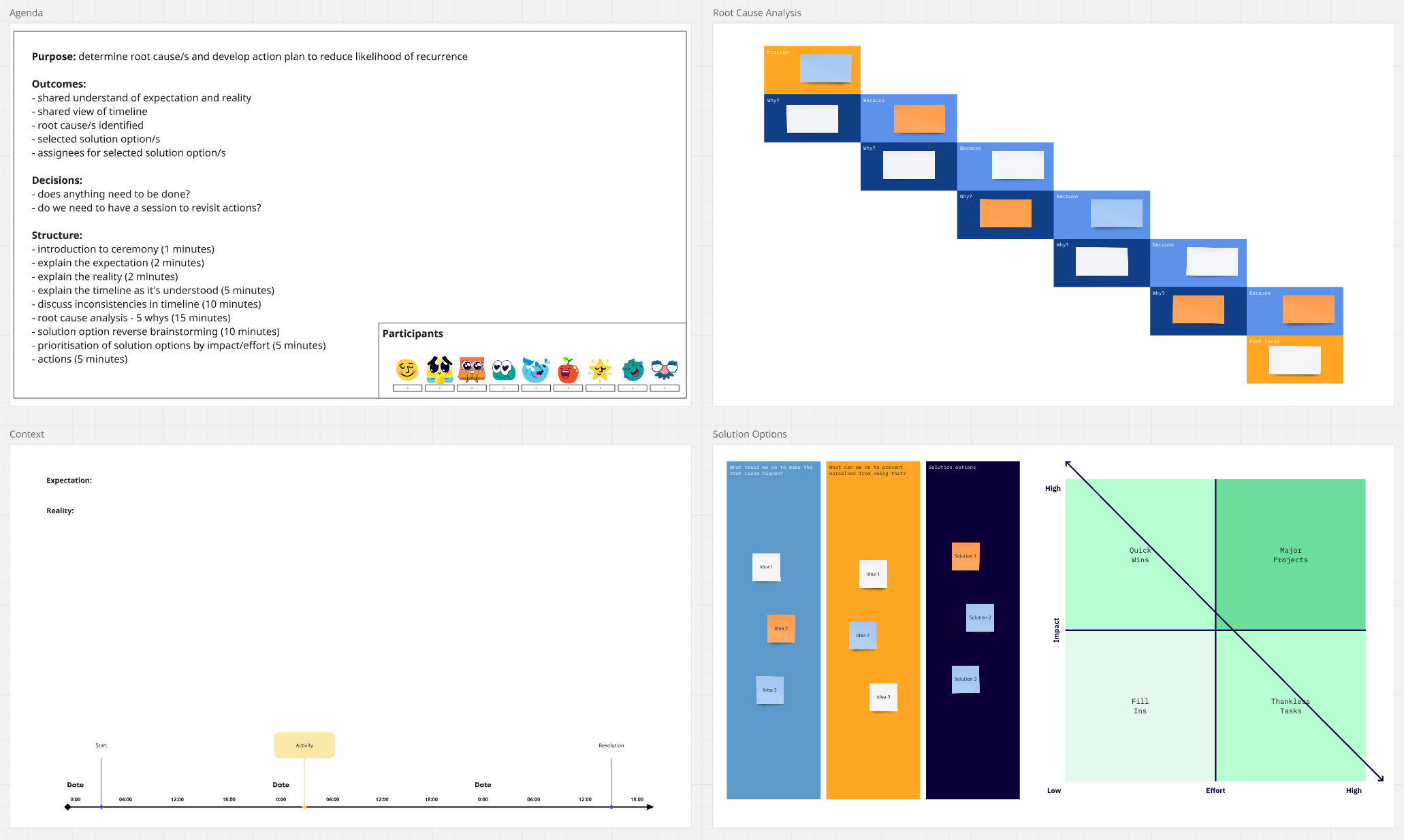Published on
Running a Successful Post-Incident Review (PIR)
Introduction
Post-Incident Reviews (PIR) are essential to understanding the root causes of incidents, ensuring continuous improvement, and preventing recurrence. A well-structured PIR enables teams to align on expectations, identify gaps, and develop actionable solutions in a blameless and constructive manner.
Template

PIR Agenda
This agenda is structured using the PODS framework (Purpose, Outcome, Decisions, Structure).
Purpose: Determine root cause(s) and develop an action plan to reduce the likelihood of recurrence.
Outcomes:
- Shared understanding of expectation vs. reality.
- A common view of the incident timeline.
- Identified root cause(s).
- Selected solution options.
- Assigned ownership for implementing solutions.
Decisions:
- Does anything need to be done?
- Should we schedule a follow-up session to revisit actions?
Structure
-
Introduction to the Ceremony (1 min) Set the tone, reinforce blameless culture, and outline the session’s purpose.
-
Explain the Expectation (2 min) Review what was expected to happen (normal operation, expected behavior, or standard procedure).
-
Explain the Reality (2 min) Describe what actually happened and how it deviated from expectations.
-
Explain the Timeline as Understood (5 min) Document the incident timeline, capturing key events and actions taken.
-
Discuss Inconsistencies in Timeline (10 min) Identify gaps, missing information, and discrepancies.
-
Root Cause Analysis - 5 Whys (15 min) Use the "5 Whys" technique to trace the root cause(s) of the incident.
-
Solution Option Reverse Brainstorming (10 min) Instead of directly proposing solutions, brainstorm ways to make the problem worse. This technique helps identify overlooked factors and creative solutions.
-
Prioritization of Solution Options by Impact/Effort (5 min) Rank proposed solutions based on their effectiveness and feasibility.
-
Actions (5 min) Assign action items with clear ownership and deadlines.
Best Practices for Post-Incident Reviews
Establish a Blameless Culture
Encourage transparency by allowing individuals to share their experiences without fear of blame or punishment. This fosters trust and ensures comprehensive insights.
Avoid Pointing Fingers
Focus on actions, results, and impact rather than assigning personal responsibility. Use neutral language that promotes learning rather than fault-finding.
Keep Critique Constructive
While maintaining a safe discussion space, ensure that critical issues are not avoided. Encourage the team to dig deep using the "5 Whys" methodology to uncover contributing factors.
Review Every PIR
A PIR without follow-up is ineffective. Schedule regular reviews with relevant teams (engineering, customer support, operations) to discuss lessons learned and ensure actions are implemented.
Root Cause Analysis: The 5 Whys
The "5 Whys" is a simple but effective technique for identifying root causes:
- Ask "Why?" regarding the incident.
- For each answer, ask "Why?" again.
- Continue this process at least five times until reaching the fundamental cause.
Example:
- Why did the system go down? → A critical service crashed.
- Why did the service crash? → It ran out of memory.
- Why did it run out of memory? → A background process consumed excessive RAM.
- Why did the process consume so much RAM? → A memory leak in recent code deployment.
- Why did the leak occur? → Insufficient testing for memory consumption before release.
The final "Why" identifies the root cause, which can then be addressed effectively.
Solution Generation: Reverse Brainstorming
Instead of directly brainstorming solutions, reverse brainstorming flips the approach:
- Step 1: Ask, "How could we make this problem worse?"
- Step 2: List ideas that would exacerbate the issue.
- Step 3: Reverse these ideas into potential solutions.
Example:
- How could we make system failures more frequent? → Deploy untested code, ignore monitoring alerts, reduce redundancy.
- Reversing these: Implement better testing, improve alert response, increase system redundancy.
This technique ensures that teams explore creative and overlooked solutions.
Conclusion
A structured PIR process enhances learning, improves system reliability, and fosters a culture of accountability without blame. By using the "5 Whys" technique, and reverse brainstorming for solutions, teams can ensure effective incident resolution and long-term improvements.
